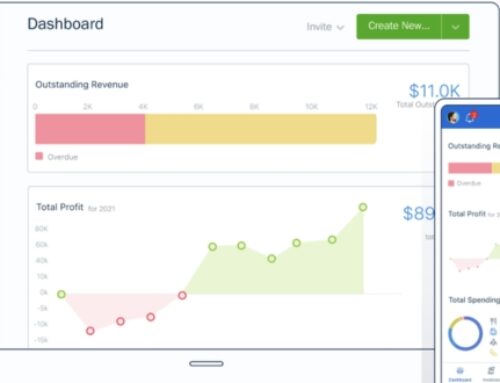Introduction: Unveiling the Power of Accurate Financial Statements
In the dynamic realm of business, the heartbeat of informed decision-making resonates within the chambers of accurate financial statements. This section delves into the pivotal role that precise financial reporting plays in steering businesses toward success and stability.
A. The Significance of Accuracy in Financial Statements
- Decision-Making Backbone:
- Explore how accurate financial statements form the bedrock for strategic decision-making.
- Highlight the impact on resource allocation, investment strategies, and operational planning.
- Investor Confidence:
- Discuss the ripple effect on investor confidence and the role of financial statements in attracting potential stakeholders.
- Emphasize the importance of transparent financial reporting in building trust.
B. FreshBooks as the Maestro of Financial Statement Streamlining
- Efficiency Redefined:
- Illuminate how FreshBooks emerges as a game-changer in simplifying and expediting financial statement processes.
- Showcase specific features that contribute to enhanced efficiency in data management and report generation.
- User-Friendly Interface:
- Highlight FreshBooks‘ user-friendly interface, making it accessible even to those without extensive financial expertise.
- Discuss how the platform transforms complex financial data into comprehensible reports.
C. Keywords for SEO Optimization: Elevating Visibility in Financial Reporting
- Financial Statement Significance:
- Dive into the importance of financial statements as a standalone keyword.
- Explore variations such as “Significance of Accurate Financial Reporting” for comprehensive coverage.
- FreshBooks for Financial Reporting:
- Position FreshBooks as a keyword to attract users specifically seeking solutions for financial reporting.
- Consider variations like “Optimizing Financial Statements with FreshBooks.”
As we embark on this journey through financial statement preparation, the convergence of accuracy and efficiency, amplified by FreshBooks, sets the stage for a deeper exploration into the intricate web of financial reporting intricacies.
Understanding Financial Statements: Basics and Components
Understanding financial statements is akin to deciphering the language of a business’s financial health. This section unfolds the fundamental components, demystifying the intricate layers of balance sheets, income statements, and cash flow statements.
A. Navigating the Balance Sheet Landscape
- Assets Unveiled:
- Embark on a journey through the asset side of the balance sheet, unraveling the tangible and intangible resources that fuel a company’s operations.
- Delve into examples and real-world applications to enhance comprehension.
- Liabilities Exposed:
- Explore the other side of the equation, investigating the liabilities that represent a company’s financial obligations.
- Illustrate how liabilities, both current and long-term, paint a comprehensive financial picture.
- Equity: The Financial Identity:
- Shed light on the equity section, showcasing how it represents the residual interest of the owners in the company.
- Provide insights into the significance of equity in measuring overall financial health.
B. The Symphony of Income Statements
- Melody of Revenue:
- Explore the top line by dissecting the revenue section, unraveling the diverse sources of income.
- Relate revenue to business operations, emphasizing its pivotal role in sustainability and growth.
- Harmony of Expenses:
- Dive into the intricacies of expenses, categorizing them into operating and non-operating expenses.
- Explain how expense management is crucial for profitability and financial sustainability.
- Profit/Loss Crescendo:
- Culminate in the profit/loss section, interpreting how it encapsulates the financial outcome of a company’s operations.
- Highlight the impact of profit/loss on decision-making and overall business trajectory.
C. Navigating the Currents of Cash Flow Statements
- Operational Rhythms:
- Examine the operational activities driving the cash flow statement, encompassing day-to-day transactions.
- Illustrate how positive operating cash flow reflects a company’s ability to generate cash internally.
- Investing and Financing Waves:
- Navigate through the investing and financing activities, showcasing how they shape the financial trajectory of a business.
- Emphasize the interplay between investment decisions and financial stability.
Navigating FreshBooks for Financial Statement Preparation
A. Accessing Financial Reporting Tools:
- Generate Standard Reports with Ease:
FreshBooks takes the hassle out of generating the essential financial statements needed for valuation. Forget manual data entry and complex calculations; with a few clicks, you can access:
- Income Statements: Track your revenue, expenses, and net income over chosen periods, providing a clear picture of your financial performance.
- Balance Sheets: Gain instant insight into your assets, liabilities, and owner’s equity, offering a snapshot of your financial health at any given time.
- Cash Flow Statements: Analyze your cash inflows and outflows, revealing how you generate and utilize your working capital.
These reports serve as the foundation for valuation calculations, providing crucial data points for applying methods like the income approach or the cost approach.
- Customize Reports for Deeper Dives:
FreshBooks isn’t just about pre-built reports. Dive deeper into your financials with powerful customization options:
- Filter by Date: Analyze specific periods to track trends, identify seasonal variations, or isolate specific events impacting your finances.
- Category Breakdown: Drill down into specific expense categories to identify areas for cost optimization or understand your revenue streams better.
- Compare Different Versions: Track progress and analyze the impact of strategic decisions by comparing reports from different periods.
These customization features empower you to tailor your reports to specific valuation needs, revealing hidden insights and providing a more nuanced understanding of your financial performance.
B. Integrating Bank Accounts and Financial Data:
- Seamless Bank Account Integration: Say goodbye to manual data entry! FreshBooks seamlessly connects with your bank accounts, automatically importing transactions and syncing balances. This ensures your financial reports reflect the most up-to-date information, boosting the accuracy and reliability of your valuation calculations.
- Comprehensive Data Aggregation: FreshBooks doesn’t stop at bank accounts. Integrate with other financial platforms and services you use, such as PayPal or Stripe, to consolidate all your financial data in one central location. This holistic view of your finances provides a complete picture for a more accurate and comprehensive valuation.
- Automatic Reconciliation: FreshBooks automates the tedious task of reconciling bank statements, eliminating errors and ensuring your financial records are always accurate. This adds another layer of confidence to your valuation data, making it more attractive to potential investors or buyers.
C. Beyond Reports: Financial Data Insights for Valuation:
FreshBooks offers more than just reports. Leverage the platform’s insightful features to gain valuable data points for your valuation:
- Profitability Trends: Analyze historical and projected profit margins to understand your business’s earning potential, a key factor in valuation calculations.
- Customer Lifetime Value: Track customer acquisition costs and average order values to assess the profitability of your customer base, impacting your business’s long-term value.
- Inventory Turnover: Analyze how efficiently you manage your inventory, influencing your operational costs and overall financial health, which are crucial for valuation.
By actively utilizing FreshBooks’ data insights, you can not only generate accurate financial reports but also build a compelling narrative around your business’s value proposition, making it more attractive to investors or potential buyers.
Balance Sheet Preparation in FreshBooks
Understanding your financial health is crucial for any business owner, and the balance sheet is your trusty compass, providing a snapshot of your assets, liabilities, and equity at any given point in time. In this section, we’ll delve into how FreshBooks empowers you to effortlessly create and analyze your balance sheet for a clear understanding of your financial standing and its impact on your business valuation.
A. Assets Management:
FreshBooks makes tracking your assets a breeze. Here’s how you can effectively manage your asset categories:
- Current Assets:
- Cash and Cash Equivalents: Track your readily available cash, bank accounts, and short-term investments.
- Accounts Receivable: Monitor outstanding payments from customers, ensuring accurate receivables and potential cash flow.
- Inventory: Manage your inventory levels, cost of goods sold, and depreciation for a comprehensive understanding of your stock value.
- Prepaid Expenses: Keep track of prepaid expenses like rent, insurance, or subscriptions to accurately reflect your financial position.
- Fixed Assets:
- Property and Equipment: List and track the value of your tangible assets like buildings, vehicles, and machinery.
- Intangible Assets: Include intellectual property like patents, trademarks, and copyrights that contribute to your business’s long-term value.
FreshBooks provides detailed reports for each asset category, allowing you to analyze trends, track performance, and make informed decisions about asset acquisition, depreciation, and potential valuation adjustments.
B. Liabilities Tracking:
Understanding your liabilities is equally important. FreshBooks helps you keep them under control:
- Current Liabilities:
- Accounts Payable: Track outstanding payments to vendors and suppliers to maintain healthy relationships and avoid late payment penalties.
- Accrued Expenses: Monitor expenses incurred but not yet paid, such as salaries or utilities, for a complete picture of your financial obligations.
- Short-Term Loans: Track any short-term debt you’ve taken on, ensuring timely repayments and reflecting their impact on your cash flow.
- Long-Term Liabilities:
- Long-Term Loans: Monitor long-term debt like mortgages or business loans, including principal and interest payments due.
- Other Long-Term Liabilities: Track any other long-term financial obligations like lease payments or deferred tax liabilities.
FreshBooks helps you analyze your liabilities in relation to your assets, providing a clear picture of your financial leverage and its impact on your overall financial health and potential valuation.
C. Equity Calculation:
FreshBooks automatically calculates your owner’s equity, which represents your residual claim on the business’s assets after liabilities are paid. This includes:
- Contributed Capital: The initial investment you and other shareholders made in the business.
- Retained Earnings: The accumulated profits reinvested in the business over time.
Understanding your equity is crucial for assessing your ownership stake, dividend distribution possibilities, and the attractiveness of your business to potential investors. FreshBooks makes it easy to track these metrics and analyze their impact on your overall financial position and valuation potential.
Income Statement Preparation with FreshBooks
The income statement, your business’s financial pulse, tells the story of your earnings and expenses over a specific period. In this section, we’ll explore how FreshBooks empowers you to effortlessly create and analyze your income statement, gaining valuable insights into your profitability and its impact on your business valuation.
A. Revenue Recording:
FreshBooks makes tracking your income a seamless process:
- Sales:
- Invoice Income: Track revenue generated from your core business, ensuring accurate sales records and automatic income updates.
- Other Income: Record income from non-core sources like interest earned, rental income, or investment dividends.
- Customization Options:
- Categorize Revenue: Organize your income by source, product, or service for deeper insights into your revenue streams and performance.
- Set Tax Rates: Define taxes applicable to different revenue categories for accurate tax reporting and financial analysis.
FreshBooks provides detailed reports on sales and other income, allowing you to analyze trends, identify growth areas, and make informed decisions about pricing, marketing, and product offerings, all impacting your valuation potential.
B. Expense Tracking:
FreshBooks helps you stay on top of your expenses:
- Operating Expenses:
- Direct Expenses: Track costs directly related to producing your goods or services, like materials, labor, and manufacturing costs.
- Indirect Expenses: Monitor overhead costs like rent, utilities, and marketing expenses.
- Non-Operating Expenses:
- Interest Expense: Track interest payments on loans or debt, impacting your profitability.
- Other Expenses: Record any non-operating expenses like losses on asset sales or extraordinary expenses.
FreshBooks allows you to categorize expenses, set budgets, and track trends, providing a clear picture of your cost structure and identifying areas for potential optimization. This can significantly improve your profitability and enhance your business’s valuation appeal.
C. Profit/Loss Calculation:
FreshBooks automatically calculates your net income, the difference between your total revenue and total expenses. This metric is crucial for assessing your overall profitability, financial health, and potential valuation.
Additional Insights:
- Gross Margin: Analyze your gross profit margin, the percentage of revenue remaining after deducting direct costs. This provides valuable insights into your operational efficiency and pricing strategies.
- Net Profit Margin: Understand your net profit margin, the percentage of revenue remaining after deducting all expenses. This is a key metric for investors and potential buyers, impacting your business’s valuation.
Cash Flow Statement Generation in FreshBooks
The cash flow statement, your business’s financial heartbeat, reveals how you generate and utilize cash over a specific period. In this section, we’ll explore how FreshBooks simplifies cash flow statement creation and analysis, empowering you to understand your liquidity and its impact on your business valuation.
A. Operating Activities:
FreshBooks tracks cash inflows and outflows related to your core business operations:
- Cash Inflows:
- Customer Receipts: Track cash received from sales and other operating income sources like service fees or rental payments.
- Interest Earned: Monitor interest income earned on investments or bank accounts.
- Cash Outflows:
- Supplier Payments: Track payments made to vendors for materials, inventory, or other operating expenses.
- Employee Payroll: Monitor salaries, wages, and benefits paid to employees.
- Operating Expenses: Track payments for rent, utilities, insurance, and other overhead costs.
Analyzing your operating activities reveals your ability to generate cash from core operations, a crucial factor for sustaining your business and attracting investors. FreshBooks provides detailed reports on operating cash flow, allowing you to identify trends, optimize your cash management practices, and improve your financial stability, all positively impacting your valuation.
B. Investing and Financing Activities:
FreshBooks also tracks cash activities related to investments and financing:
- Investing Activities:
- Asset Purchases: Monitor cash used to purchase property, equipment, or other long-term assets.
- Asset Sales: Track cash received from selling assets, providing insights into your asset management strategies.
- Financing Activities:
- Debt Financing: Monitor cash received from loans or other debt instruments.
- Equity Financing: Track cash received from issuing shares or attracting investors.
Analyzing your investing and financing activities provides insights into your capital structure and funding sources, influencing your long-term financial stability and potential valuation. FreshBooks offers reports on these activities, allowing you to make informed decisions about investments, debt management, and attracting capital, all impacting your business’s attractiveness to potential buyers or investors.
Financial Ratios and Analysis
The numbers dance, the reports pile up, and you’re left wondering, “What do they all mean?” Fear not, intrepid entrepreneur! This section is your Rosetta Stone for deciphering the language of financial ratios, empowering you to use FreshBooks data to gain valuable insights and strengthen your business valuation.
A. Overview of Key Financial Ratios:
Think of financial ratios as financial health checkups. They take your numbers from FreshBooks and turn them into actionable stories about your business. Here are some key categories to explore:
- Liquidity Ratios: These measure your ability to meet short-term obligations, like the Current Ratio (Current Assets/Current Liabilities) or Quick Ratio (Current Assets – Inventory/Current Liabilities).
- Solvency Ratios: These assess your long-term financial health and ability to repay debt, such as the Debt-to-Equity Ratio (Total Liabilities/Shareholder’s Equity) or Debt Service Coverage Ratio (Operating Income/Total Debt Service).
- Profitability Ratios: These measure your ability to generate earnings and return on investment, like the Net Profit Margin (Net Income/Sales) or Return on Assets (Net Income/Total Assets).
B. Analyzing Liquidity, Solvency, and Profitability Ratios:
Let’s dive deeper into each category:
- Liquidity Ratios:
- A high Current Ratio indicates strong liquidity, while a low one suggests potential difficulty meeting short-term obligations.
- The Quick Ratio excludes inventory, providing a more conservative view of your immediate cash availability to cover short-term debts.
- Solvency Ratios:
- A high Debt-to-Equity Ratio indicates a higher reliance on debt, which could raise concerns for investors or lenders.
- A strong Debt Service Coverage Ratio indicates your ability to comfortably handle your debt obligations.
- Profitability Ratios:
A high Net Profit Margin shows you’re generating significant profit from your sales.
A good Return on Assets indicates you’re efficiently utilizing your assets to generate income.
FreshBooks makes analyzing these ratios a breeze:
- Generate pre-built reports with key ratios.
- Customize reports to compare different periods or analyze specific aspects of your business.
- Track trends over time to identify areas for improvement.
Utilizing FreshBooks for Budgeting and Forecasting
FreshBooks isn’t just about recording past financial data; it empowers you to plan for the future with budgeting and forecasting tools.
A. Budget Creation and Management:
- Set Realistic Goals: Define your revenue and expense targets for specific periods to guide your financial roadmap.
- Allocate Resources: Assign budget amounts to different departments, projects, or expense categories for strategic control.
- Track Performance: Compare actual expenses against your budget in real-time to identify variances and make adjustments as needed.
B. Forecasting Future Financial Performance:
- Leverage Historical Data: Utilize FreshBooks reports and trends to project future revenue and expenses, anticipating potential challenges and opportunities.
- Scenario Planning: Build different forecast models based on varying assumptions to prepare for diverse economic conditions.
Informed Decision-Making: Use your forecasts to make informed strategic decisions about investment, pricing, marketing, and resource allocation.
Financial Statement Review and Audit Preparation
Maintaining accurate and up-to-date financial statements is crucial for both valuation and peace of mind. FreshBooks makes it easy to:
A. Conduct Periodic Financial Statement Reviews:
- Utilize FreshBooks reports and tools to regularly assess your financial health and identify potential issues early on.
- Compare actual results against budgets and forecasts to measure progress and adjust strategies if needed.
B. Prepare for Financial Audits with FreshBooks:
- Streamline the audit process with readily accessible, organized financial data in FreshBooks.
- Reduce preparation time and costs by providing auditors with readily exportable reports and documentation.
- Demonstrate financial transparency and compliance with accounting standards, boosting confidence among investors and stakeholders.
Tips for Efficient Financial Statement Preparation
Conquering the financial statement mountain doesn’t have to be an epic climb. FreshBooks equips you with tools to make the process faster, smoother, and stress-free.
A. Streamlining Processes with FreshBooks Features:
- Automate Data Entry: Reduce manual work and errors with automatic bank account syncs and expense categorization.
- Generate Reports in Minutes: Access pre-built reports for income statements, balance sheets, and cash flow statements with just a few clicks.
Customize for Deeper Insights: Tailor reports by date, category, or other filters to gain specific financial intelligence.
B. Ensuring Accuracy and Compliance:
- Maintain Audit-Ready Records: FreshBooks adheres to accounting standards, providing confidence in your financial data.
- Track Expenses Easily: Capture receipts and categorize transactions on the go with the FreshBooks mobile app.
- Stay Compliant with Tax Regulations: Generate tax reports and estimates directly from FreshBooks data.
Conclusion
As we conclude our expedition into the realm of FreshBooks Financial Statement Preparation, it’s evident that this platform transcends traditional accounting. FreshBooks emerges not just as a tool but as a compass guiding businesses through the intricacies of financial statement creation, interpretation, and compliance.
Navigating Clarity:
FreshBooks transforms financial complexity into clarity, empowering businesses to understand, strategize, and thrive. The journey through this content has illuminated the pivotal role FreshBooks plays in steering financial health.
Efficiency in Every Digit:
From demystifying balance sheets to orchestrating income statements and orchestrating cash flow narratives, FreshBooks brings efficiency to every digit. Its user-friendly interface, coupled with robust features, makes financial statement preparation an intuitive and streamlined process.
Compliance Confidence:
In the ever-evolving landscape of regulations and audits, FreshBooks stands as a beacon of compliance confidence. It not only facilitates smooth audit preparations but also ensures that financial reviews are insightful and strategic.
As your financial ally, FreshBooks doesn’t just manage numbers; it nurtures the financial heartbeat of your business. Let the chapters we’ve explored serve as a compass for leveraging FreshBooks to its fullest potential, ensuring that your financial statements not only reflect the past but illuminate the path to future success. With FreshBooks, financial clarity is not just a destination; it’s the journey toward sustained prosperity.









